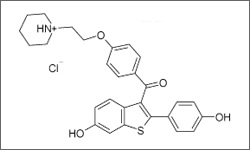Raloxifene

Brand name:
EVISTA®
IUPAC:
[6-hydroxy-2-(4-hydroxyphenyl)- benzothiophen-3-yl]- [4-[2-(1-piperidyl)ethoxy]phenyl] -methanone
FDA approval:
Yes
Usage:
Raloxifene is used in post-menopausal women who are at high risk of invasive breast cancer or have osteoporosis in order to reduce their risk. Studies are being done to test its usefulness of breast cancer prevention in certain pre-menopausaual women.1
- 1 Raloxifene. MedlinePlus. 2016. https://medlineplus.gov/druginfo/meds/a698007.html
Mechanism:
Raloxifene binds to estrogen receptors, thereby blocking some estrogenic pathways and activating others. Raloxifene works by blocking the effects of estrogen on breast tissue, which can stop the growth of cancer that feeds off estrogen.1
The diagram above shows the 3D molecular structure of Raloxifene.
- 1 Raloxifene. MedlinePlus. 2016. https://medlineplus.gov/druginfo/meds/a698007.html
